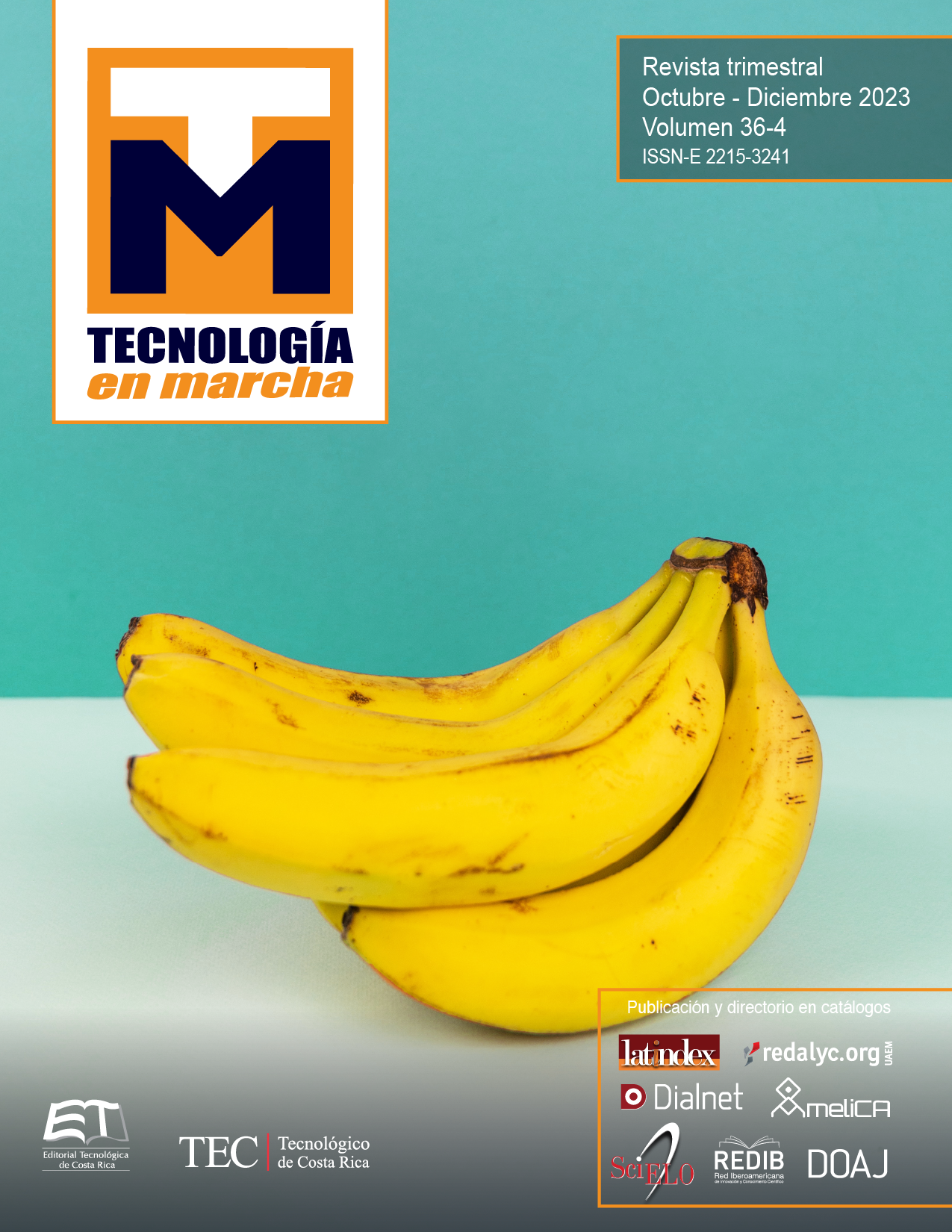Community water monitoring strategy for the Jorco river micro-basin based on the analysis of physicochemical, microbiological and biological indicators of water quality
Main Article Content
Abstract
The profound deficiencies that the country faces in water management policies are reflected in the physicochemical, microbiological and biological contamination of national rivers. The objective of this study was to propose a community water monitoring strategy to improve the management of the Jorco River located in the canton of Acosta. The quality of the water in the upper, middle and lower part of the micro-basin was monitored during the rainy season, using two physicochemical quality indices (ICA): the Dutch and the Calvo-TEC; as well as a biological one: the BMWP-CR. The quality indicators of turbidity, alkalinity, ammonia, ammoniacal nitrogen, nitrates, and fecal coliforms exceeded the permissibility limits in some samples; however, dissolved oxygen showed that there are good levels of oxygen for river recovery. Biochemical oxygen demand was low, indicating low organic load, and macroinvertebrates showed a degraded aquatic ecosystem. The Dutch ICA overestimated the quality of the water with respect to the ICA Calvo-TEC. The latter showed more realistic results because it uses more quality indicators, since it is based on environmental conditions and Costa Rican regulations. The ICA BMWP-CR revealed extreme contamination during the month of greatest rainfall. It was concluded that there is a problem of contamination in the river water whose main causes may be due to the lack of forest cover in the riparian zones, the expansion of coffee cultivation, the discharge of domestic wastewater and livestock activities. Therefore, an action plan was proposed to the municipal council and validated with them, to improve water quality with the participation of different actors in the area.
Article Details

This work is licensed under a Creative Commons Attribution-NonCommercial-NoDerivatives 4.0 International License.
Los autores conservan los derechos de autor y ceden a la revista el derecho de la primera publicación y pueda editarlo, reproducirlo, distribuirlo, exhibirlo y comunicarlo en el país y en el extranjero mediante medios impresos y electrónicos. Asimismo, asumen el compromiso sobre cualquier litigio o reclamación relacionada con derechos de propiedad intelectual, exonerando de responsabilidad a la Editorial Tecnológica de Costa Rica. Además, se establece que los autores pueden realizar otros acuerdos contractuales independientes y adicionales para la distribución no exclusiva de la versión del artículo publicado en esta revista (p. ej., incluirlo en un repositorio institucional o publicarlo en un libro) siempre que indiquen claramente que el trabajo se publicó por primera vez en esta revista.
References
Calvo, G. (2015). Ríos: Fundamentos sobre su Calidad y la Relación con el Entorno Socioambiental. San José, Costa Rica. Editorial Tecnológica de Costa Rica.
MINAE (1997). Decreto Ejecutivo Nº 25721-MINAE. “Ley Forestal”. Publicado en La Gaceta Oficial n° 16, Jueves 23 de enero de 1997. San José, Costa Rica.
MINAE (2002). Resolución N 5666-2002. Recuperado de http://www.merlink.co.cr:8084/search/EP_SEJ_EXA257.jsp?cartelNo=20150400160&cartelSeq=00&cartelCate=1&biddocUnikey=D20150421131716135114296438369160&reAdjuCnt=0
Göransson, G., Norrman, J., and Larson, M. (2018). Contaminated landslide runout deposits in rivers: Method for estimating long-term ecological risks. Science of The Total Environment, Volume 642, pp 553-566. ISSN 0048-9697. https://doi.org/10.1016/j.scitotenv.2018.06.078.
Mora, E. (2014). Asignan casas a beneficiarios de proyecto El Tablazo en Acosta. El Jornal. Recuperado de http://eljornalcr.com/asignan-casas-a-beneficiarios-de-proyecto-el-tablazo-en-acosta/
IMN (2011). Estudio de Cuencas Hidrográficas de Costa Rica: Cuenca del río Parrita. Recuperado de http://cglobal.imn.ac.cr/sites/default/files/documentos/cuenca_rio_parrita_1.pdf
Hu, Y., Yang-Liu, C. and Chen T. (2017). Ecological improvement and community participation: lessons from Xiaoqing River Ecological Improvement Project in Jinan, China. Community Development Journal 52(1):21-37. DOI: 10.1093/cdj/bsw049
Calvo-Brenes, G. (2018). Índices e indicadores sobre la calidad del agua, 1th ed. Cartago, Costa Rica, ET. ISBN 978-9977-66-454-5.
MINAE (2007). Reglamento para la evaluación y clasificación de la calidad de cuerpos de agua superficiales, La Gaceta, no. 33903-MINAE-S, 2007.
Calvo-Brenes, G. (2019). Nuevo índice para valorar la calidad de aguas superficiales en Costa Rica. Revista Tecnología en Marcha, 32 (4), p 104-115
Ortiz, E. (2014). Atlas digital de Costa Rica 2008. Instituto Tecnológico de Costa Rica. Escuela de Ingeniería Forestal.
APHA, AWWA and AEF, “Standard methods for the examination of water and wastewater”, 23rd ed. WA, DC, USA, 2017.
Dojlido, J., Raniszewski, j., and Woyciechowska, J. (1994). Water quality index applied to rivers in the vistula river basin in Poland. Environmental monitoring and assessment, vol. 33, pp. 33-42.
Landwehr, J. (1974). Water quality indices: construction and analysis. Tesis doctoral. University of Michigan, United States of America.
Ferreira, A. (2015). Respuestas poblacionales de macroinvertebrados a distintas calidades de agua en cuerpos loticos de la llanura pampeana. (Tesis doctoral). Facultad de Ciencias Naturales y Museo, Buenos Aires, Argentina. Recuperado de http://sedici.unlp.edu.ar/handle/10915/44807
Perevochtchikova, M., Aponte, N., Zamudio, V., y G, Sandoval, (2016). Monitoreo comunitario participativo de la calidad del agua: caso Ajusco, México. Tecnología y Ciencias del Agua 7(6), 5-23.
Lancaster, J. (2008). Movement and dispersion of insects of stream channels: What role does flow play? En Lancaster, J., y Briers, R. (Eds.). Aquatic Insects: Challenges to Populations (p.139-157). North American, Editorial CABI.
Salazar-Cespedes, K. (2018). Estrategia de Monitoreo Hídrico Comunitario para la microcuenca río Jorco basado en el análisis de indicadores fisicoquímicos, microbiológicos y biológicos de la calidad de agua. Tesis de grado. Universidad Estatal a Distancia. San José, Costa Rica.

